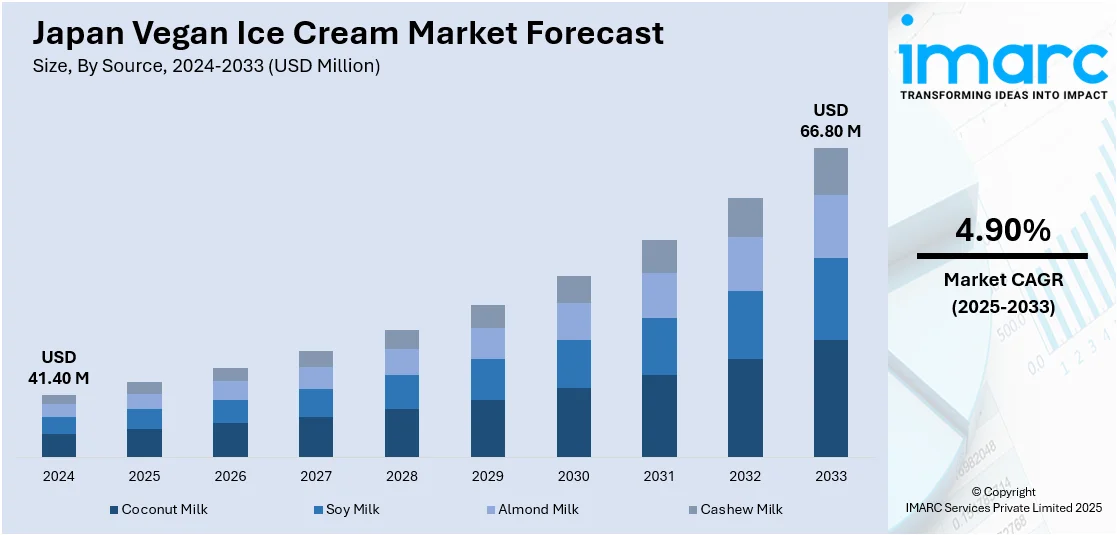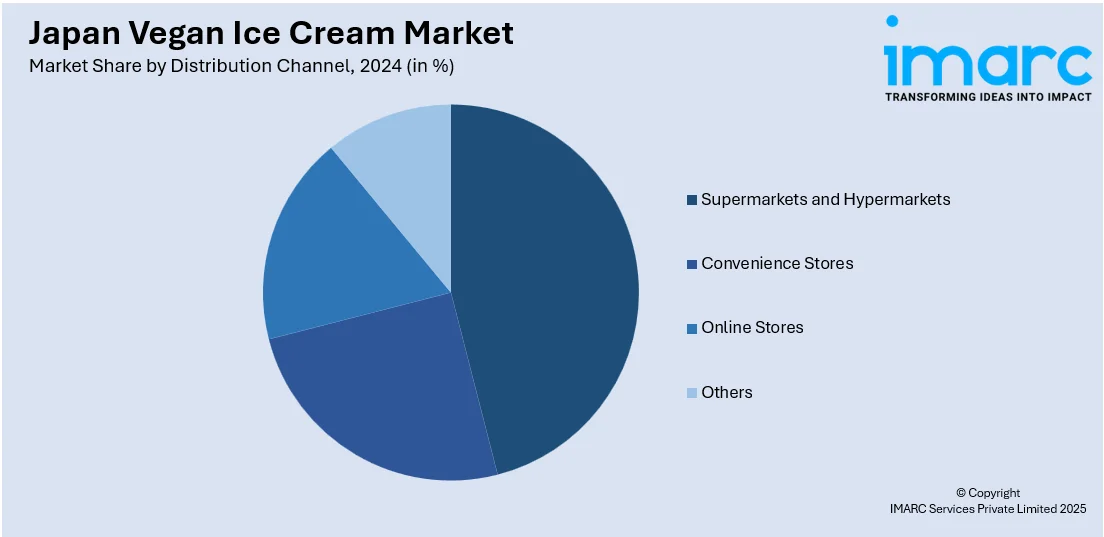
Japan Vegan Ice Cream Market Size, Share, Trends and Forecast by Source, Flavor, Sales Type, Distribution Channel, and Region, 2025-2033
Japan Vegan Ice Cream Market Overview:
The Japan vegan ice cream market size reached USD 41.40 Million in 2024. Looking forward, IMARC Group expects the market to reach USD 66.80 Million by 2033, exhibiting a growth rate (CAGR) of 4.90% during 2025-2033. The market is being driven by increasing health consciousness, rising demand for lactose-free and dairy-free alternatives, environmental sustainability trends, and the growing number of consumers seeking plant-based products as part of their lifestyle choices and efforts to reduce their carbon footprint.
|
Report Attribute
|
Key Statistics
|
|---|---|
|
Base Year
|
2024 |
|
Forecast Years
|
2025-2033
|
|
Historical Years
|
2019-2024
|
| Market Size in 2024 | USD 41.40 Million |
| Market Forecast in 2033 | USD 66.80 Million |
| Market Growth Rate 2025-2033 | 4.90% |
Japan Vegan Ice Cream Market Trends:
Growing Health Consciousness Among Consumers
Among the chief drivers of the Japanese vegan ice cream market is the increased health awareness among consumers. As consumers in Japan become cognizant of the negative impacts of conventional dairy products on their health, such as lactose intolerance and high cholesterol levels, there has been propelling demand for dairy-free products. Plant-based, lactose- and animal fat-free ice cream provides a very attractive alternative for someone seeking to enhance their general well-being or lead a healthier lifestyle. Plant-based diets are widely being adopted by many Japanese consumers because they believe that vegan foods have less saturated fat and no added preservatives in the regular dairy foods. In addition, Japanese people have historically been lactose intolerant, providing a natural market for dairy-free products such as vegan ice cream. The products' demand is not only because consumers want a healthier diet but also due to the rising issues about the possible connections between the consumption of dairy and health complications such as acne, digestive issues, and cardiovascular disease.

Environmental Awareness and Sustainability Trends
Another significant factor driving the Japan vegan ice cream market is growing environmental consciousness and the elevating demand for sustainable food items. Japanese consumers, especially the younger generation, are extensively becoming environmentally conscious and are actively looking for alternatives with lower environmental footprints. The manufacture of dairy foods is energy-intensive, involving large quantities of water, land, and energy, and generating high levels of greenhouse gas emissions. This has prompted many environmentally conscious consumers to switch to plant-based foods such as vegan ice cream, which generally have a much lower carbon footprint and use fewer resources to make. The Japanese market is also witnessing an increase in the adoption of sustainable practices by companies. Several ice cream companies are launching vegan products as part of their sustainability efforts and minimizing their carbon footprint. These initiatives are proving to be effective with consumers who are willing to support companies that share their values on climate change and sustainability.
Japan Vegan Ice Cream Market Segmentation:
IMARC Group provides an analysis of the key trends in each segment of the market, along with forecasts at the region/country level for 2025-2033. Our report has categorized the market based on source, flavor, sales type, and distribution channel.
Source Insights:
- Coconut Milk
- Soy Milk
- Almond Milk
- Cashew Milk
The report has provided a detailed breakup and analysis of the market based on the source. This includes coconut milk, soy milk, almond milk, and cashew milk.
Flavor Insights:
- Chocolate
- Caramel
- Coconut
- Vanilla
- Coffee
- Fruit
A detailed breakup and analysis of the market based on the flavor have also been provided in the report. This includes chocolate, caramel, coconut, vanilla, coffee, and fruit.
Sales Type Insights:
- Impulse
- Take Home
- Artisanal
The report has provided a detailed breakup and analysis of the market based on the sales type. This includes impulse, take home, and artisanal.
Distribution Channel Insights:

- Supermarkets and Hypermarkets
- Convenience Stores
- Online Stores
- Others
A detailed breakup and analysis of the market based on the distribution channel have also been provided in the report. This includes supermarkets and hypermarkets, convenience stores, online stores, and others.
Regional Insights:
- Kanto Region
- Kansai/Kinki Region
- Central/Chubu Region
- Kyushu-Okinawa Region
- Tohoku Region
- Chugoku Region
- Hokkaido Region
- Shikoku Region
The report has also provided a comprehensive analysis of all the major regional markets, which include Kanto Region, Kansai/Kinki Region, Central/Chubu Region, Kyushu-Okinawa Region, Tohoku Region, Chugoku Region, Hokkaido Region, and Shikoku Region.
Competitive Landscape:
The market research report has also provided a comprehensive analysis of the competitive landscape. Competitive analysis such as market structure, key player positioning, top winning strategies, competitive dashboard, and company evaluation quadrant has been covered in the report. Also, detailed profiles of all major companies have been provided.
Japan Vegan Ice Cream Market News:
- April 2025: The Tokyo Vegan Gourmet Festival featured over 80 vegan food stalls offering a variety of dishes, including vegan ice creams. The festival promotes transparency by listing all ingredients in Japanese, ensuring attendees can confidently enjoy meals free from animal products.
- March 2024: Eclipse Foods launched its plant-based ice cream line, "eclipseco" in Japan, offering flavors like Cookie Butter Crumble, Classic Chocolate, and Mango Passion Fruit at Family Mart stores in Tokyo. This expansion into Japan aligns with the escalating demand for plant-based alternatives in the region, driven by health and environmental concerns.
Japan Vegan Ice Cream Market Report Coverage:
| Report Features | Details |
|---|---|
| Base Year of the Analysis | 2024 |
| Historical Period | 2019-2024 |
| Forecast Period | 2025-2033 |
| Units | Million USD |
| Scope of the Report |
Exploration of Historical Trends and Market Outlook, Industry Catalysts and Challenges, Segment-Wise Historical and Future Market Assessment:
|
| Sources Covered | Coconut Milk, Soy Milk, Almond Milk, Cashew Milk |
| Flavors Covered | Chocolate, Caramel, Coconut, Vanilla, Coffee, Fruit |
| Sales Types Covered | Impulse, Take Home, Artisanal |
| Distribution Channels Covered | Supermarkets and Hypermarkets, Convenience Stores, Online Stores, Others |
| Regions Covered | Kanto Region, Kansai/Kinki Region, Central/Chubu Region, Kyushu-Okinawa Region, Tohoku Region, Chugoku Region, Hokkaido Region, Shikoku Region |
| Customization Scope | 10% Free Customization |
| Post-Sale Analyst Support | 10-12 Weeks |
| Delivery Format | PDF and Excel through Email (We can also provide the editable version of the report in PPT/Word format on special request) |
Key Questions Answered in This Report:
- How has the Japan vegan ice cream market performed so far and how will it perform in the coming years?
- What is the breakup of the Japan vegan ice cream market on the basis of source?
- What is the breakup of the Japan vegan ice cream market on the basis of flavor?
- What is the breakup of the Japan vegan ice cream market on the basis of sales type?
- What is the breakup of the Japan vegan ice cream market on the basis of distribution channel?
- What is the breakup of the Japan vegan ice cream market on the basis of region?
- What are the various stages in the value chain of the Japan vegan ice cream market?
- What are the key driving factors and challenges in the Japan vegan ice cream market?
- What is the structure of the Japan vegan ice cream market and who are the key players?
- What is the degree of competition in the Japan vegan ice cream market?
Key Benefits for Stakeholders:
- IMARC’s industry report offers a comprehensive quantitative analysis of various market segments, historical and current market trends, market forecasts, and dynamics of the Japan vegan ice cream market from 2019-2033.
- The research report provides the latest information on the market drivers, challenges, and opportunities in the Japan vegan ice cream market.
- Porter's five forces analysis assist stakeholders in assessing the impact of new entrants, competitive rivalry, supplier power, buyer power, and the threat of substitution. It helps stakeholders to analyze the level of competition within the Japan vegan ice cream industry and its attractiveness.
- Competitive landscape allows stakeholders to understand their competitive environment and provides an insight into the current positions of key players in the market.
Need more help?
- Speak to our experienced analysts for insights on the current market scenarios.
- Include additional segments and countries to customize the report as per your requirement.
- Gain an unparalleled competitive advantage in your domain by understanding how to utilize the report and positively impacting your operations and revenue.
- For further assistance, please connect with our analysts.
 Request Customization
Request Customization
 Speak to an Analyst
Speak to an Analyst
 Request Brochure
Request Brochure
 Inquire Before Buying
Inquire Before Buying




.webp)




.webp)












